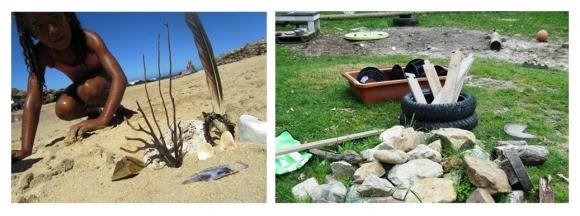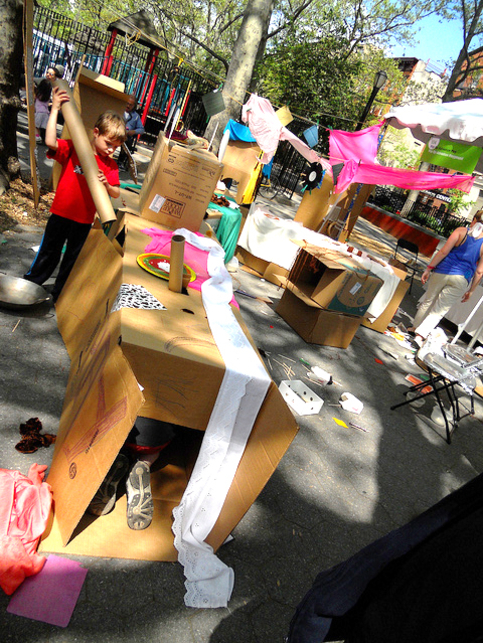Last year I visited Berlin for three months to do some research on ‘child-friendly cities’, playscapes and the ‘waldkindergarten’ (forest school) movement. While there a friend introduced me to the wonderful work of Spielwagen (Playbus). This ‘portable playground’ began in the late 1970’s, in the old eastern-bloc district of Friedrichshain, by a group whose “mission was to view the city as playground, enhance free play and creativity and devote time for children.” Most of the toys are custom-made by the project and there are some really quirky and irresistible designs (see below). They visit the same 5 parks on rotation, afterschool and on holidays, Monday to Friday, nearly all year round.
Following the trend of recession-proof ‘pop-up’ everything is the pop-up playground. A global movement is emerging in Australia, Colombia, Egypt, Mexico, the UK and US led by play organisation Pop Up Adventure Playground who “reclaim private and public spaces, transforming everyday landscapes into vibrant places to play with ordinary, repurposed materials such as cardboard boxes, string, yarn and tape (also known as loose parts)” The principal is very much like Spielwagen however the focus is on providing more open ended play materials/equipment – ‘loose parts’ – and there is also a big emphasis on child-directed play. Child-directed play means children choose what and how they want to play. They make the rules, and our role as adults is to provide play space and materials and only offer support when asked. Adults must not direct, try to teach, offer advice etc unless invited to do so!
“In any environment, both the degree of inventiveness and the possibility of
discovery are directly proportional to the number and kind of variables in it”
– Simon Nicholson, 1971
Loose parts was coined by landscape architect Simon Nicholson in the early 1970’s. By variables he means loose parts such as sticks, stones, sand, stumps, fabric, wood, balls, buckets, baskets, crates, boxes, rope, tyres, balls, shells etc etc. Nicholson believed loose parts empowered creativity because of the open ended nature of the materials. Play with loose parts has no ‘goal’ and there are no right or wrong answers. Anyone who works with or has children knows how children in the early years are generally more drawn to the wooden spoon, cardbox box or remote control than the fancy store bought toy. This is because they provide a blank canvas and can be used in more diverse ways than specific toys. It is also because of young children’s superior capacity for divergent thinking (a thought process used to generate creative ideas by exploring many possible solutions) that they prefer play materials with endless possibilities.
As well as giving children access to open-ended, freeform play what I also like about the pop-up playground movement is its relationship with space in the city. Similar to the vision of Spielwagen who viewed ‘the city as a playground’ it is about using public space in new ways, occupying space and also speaks to active citizenry and community organisation and cohesion.
It is also about changing perceptions towards play – “While we have worked with collaborators around the world to bring play to thousands of children and families we know that sustainable change starts at home. It starts with parents who resist the pressure to sign their children up for numerous hours of adult directed activities every day after school, ensuring that kids still have time to play. It starts in classrooms around the world where one or two teachers decide not to accept the idea that there is no time left for play at school. It starts with all of us who share the belief that play is a fundamental, essential right of every child.” – (Pop-Up Adventure Playground)
Today is Human Rights Day in South Africa, which commemorates the Sharpeville massacre in 1960. It is a day to commemorate those that lost their lives so we could stand here and enjoy more of our basic rights, although many of our people still do not enjoy these rights. Play is often seen as a frivolous, meaningless activity that is inferior to education and work. Part of this movement is to try and make people see the deep and important connections between children’s right to play and social well-being and development.
We will start Joburg’s first pop-up playground in April at the David Webster Park, Troyeville and the Drill Hall in town…..more details to follow soon.
If you are interested in setting up your own pop up playground get in touch with us – ntsiki@hummingbird.org.za or subscribe to Pop-Up Adventure Playground’s mailing list and they will send you their very informative free mini-toolkit.






[…] and after reading the Just Playing blog on portables, pop-ups and loose parts, I saw this photo and these tyres differently. There is clearly evidence here of children at play. […]
Hi Daniel,
A v delayed reaction…….
I agree that ‘directly proportional’ is too prescriptive and absolute, it would be interesting to see the original context of this statement though.
Re: What qualitative difference arises when children choose their own……… I think it is entirely possible and desirable. Want find out more about the first primary school in Reggio and how they have transferred the approach to primary level, it seems to be working very well.
Also reminds me of the Summerhill school in UK where lessons are not compulsory and children are self-directed learners. They have amazing academic results but precisely because that isn’t really the point of the school, From the Independent – “In Class 2, the teacher is sitting with Evie, 10, looking through history books so that they can decide what period she would like to study”. …from their website “To provide choices and opportunities that allow children to develop at their own pace and to follow their own interests. Summerhill does not aim to produce specific types of young people, with specific, assessed skills or knowledge, but aims to provide an environment in which children can define who they are and what they want to be.”
Sounds like a great place to work and/or study.
Excellent way of describing, and nice paragraph to obtain information concerning my presentation focus, which
i am going to present in academy.